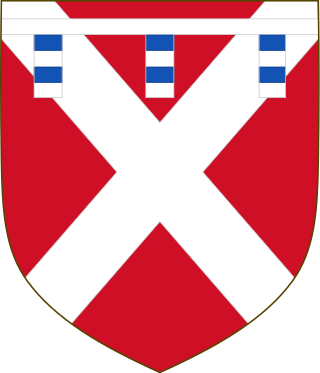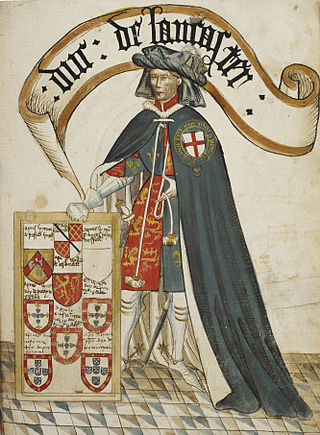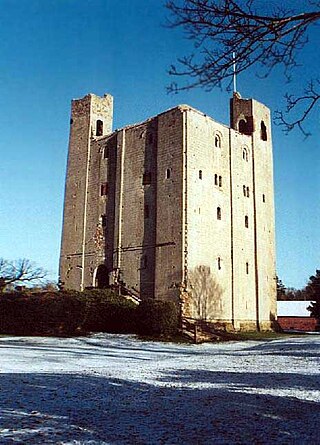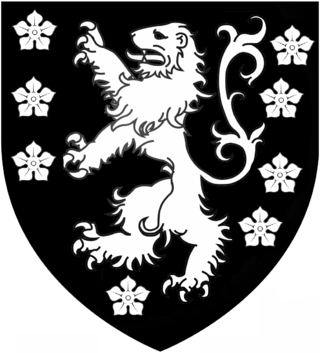
John Beaufort, 1st Duke of Somerset, 3rd Earl of Somerset, KG was an English nobleman and military commander during the Hundred Years' War. He was the maternal grandfather of Henry VII.

Richard Neville, 5th Earl of Salisbury KG PC was an English nobleman and magnate based in northern England who became a key supporter of the House of York during the early years of the Wars of the Roses. He was the father of Richard Neville, 16th Earl of Warwick, the "Kingmaker".
John Neville, 1st Marquess of Montagu was a major magnate of fifteenth-century England. He was a younger son of Richard Neville, 5th Earl of Salisbury, and the younger brother of Richard Neville, Earl of Warwick, the "Kingmaker".

Thomas Holland, 2nd Baron Holand, and jure uxoris1st Earl of Kent, KG was an English nobleman and military commander during the Hundred Years' War. By the time of the Crécy campaign, he had apparently lost one of his eyes.

Henry of Grosmont, Duke of Lancaster was an English statesman, diplomat, soldier, and Christian writer. The owner of Bolingbroke Castle in Lincolnshire, Grosmont was a member of the House of Plantagenet, which was ruling over England at that time. He was the wealthiest and most powerful peer of the realm.

The Battle of La Rochelle was a naval battle fought on 22 and 23 June 1372 between a Castilian fleet commanded by the Castilian Almirant Ambrosio Boccanegra and an English fleet commanded by John Hastings, 2nd Earl of Pembroke. The Castilian fleet had been sent to attack the English at La Rochelle, which was being besieged by the French. Besides Boccanegra, other Castilian commanders were Cabeza de Vaca, Fernando de Peón and Ruy Díaz de Rojas.

John Hastings, 2nd Earl of Pembroke, was a fourteenth-century English nobleman and soldier. He also held the titles of Baron Abergavenny and Lord of Wexford. He was born in Sutton Valence, the son of Lord Hastings, and Agnes Mortimer. His father died when John Hastings was around one year old, and he became a ward of King Edward III while remaining in his mother's care. The King arranged for John to marry Edward's daughter Margaret in 1359, which drew John into the royal family. However, Margaret died two years later. John Hastings inherited his father's earldom, subsidiary titles and estates in 1368. The same year, he made a second marriage, to Anne, daughter of Walter, Lord Mauny. The following year, Pembroke began the career in royal service that continued for the rest of his life.

Robert Willoughby, 6th Baron Willoughby de Eresby was an English nobleman and military commander in the Hundred Years' War.
Maud Francis, Countess of Salisbury was daughter of Sir Adam Francis, born c. 1326, Lord Mayor of London, and Agnes Champnes. She was married and widowed three times. Her first husband was John Aubrey and her second Sir Alan Buxhull, KG in 1372.

Robert Ufford, 1st Earl of Suffolk, KG was an English peer. He was created Earl of Suffolk in 1337.

William Latimer, 4th Baron Latimer, KG was an English noble, soldier and diplomat. After serving in France and for the household of Edward III, he was impeached during the Good Parliament of 1376, the earliest recorded impeachment in the Parliament of England.

John de Vere, 7th Earl of Oxford was the nephew and heir of Robert de Vere, 6th Earl of Oxford who succeeded as Earl of Oxford in 1331, after his uncle died without issue.

Sir Gervase Clifton of Clifton, Nottinghamshire and London was a 15th-century English knight and landowner. He was beheaded after the Battle of Tewkesbury.

John Montagu, 3rd Earl of Salisbury and 5th and 2nd Baron Montagu, KG was an English nobleman, one of the few who remained loyal to Richard II after Henry IV became king.

Thomas Montagu, 4th Earl of Salisbury, KG of Bisham in Berkshire, was an English nobleman and one of the most important English commanders during the Hundred Years' War.

The Battle of Pontvallain, part of the Hundred Years' War, took place in the Sarthe region of north-west France on 4 December 1370, when a French army under Bertrand du Guesclin heavily defeated an English force which had broken away from an army commanded by Sir Robert Knolles. The French numbered 5,200 men, and the English force was approximately the same size.

Sir Robert de Umfraville KG, Lord of Redesdale was a knight in late-medieval England who took part in the later stages of the Hundred Years' War, particularly against Scotland. The de Umfraville family had been influential in northeast England for centuries and also held major estates in Yorkshire. His ancestors were mormaers of Angus, and his nephew married into the Percies, a powerful local marcher family with whom de Umfraville was closely associated. Much of Sir Robert's career continued on the same path as his ancestors, being primarily focused on defending the border with Scotland, which had been in a state of near-permanent warfare since the late thirteenth century.

William Montagu, 2nd Earl of Salisbury, 4th Baron Montagu, King of Mann, KG was an English nobleman and commander in the English army during King Edward III's French campaigns in the Hundred Years War. He was one of the Founder Knights of the Order of the Garter.
Sir John Minsterworth was a fourteenth-century English knight from Gloucestershire, who fought in the Hundred Years' War and was executed by King Edward III for treason. Nothing is known of his upbringing but he first comes to prominence during the 1370 invasion of France. The war, under the command of the King's son, Edward the Black Prince, was going poorly and had only recently restarted after a nine-year truce. Minsterworth was part of a force sent to relieve the English command in France under the nominal leadership of Sir Robert Knolles, whom contemporaries praised for his military acumen. Landing in the north, Knolles and Minsterworth carved their way to the west of France. There, divisions among the leaders—which may have been present before the campaign began—erupted into mutiny.
In July 1385 Richard II, king of England, led an English army into Scotland. The invasion was, in part, retaliation for Scottish border raids, but was most provoked by the arrival of a French army into Scotland the previous summer. England and France were engaged in the Hundred Years' War, and France and Scotland had a treaty to support each other. The English King had only recently come of age, and it was expected that he would play a martial role just as his father, Edward the Black Prince, and grandfather Edward III had done. There was some disagreement amongst the English leadership whether to invade France or Scotland; the King's uncle, John of Gaunt, favoured invading France, to gain him a tactical advantage in Castile, the throne of which he claimed through his wife, Constance, with little success. The King's friends among the nobility – who were also Gaunt's enemies – preferred an invasion of Scotland. A parliament the year before had granted funds for a continental campaign and it was deemed unwise to flout the House of Commons. The Crown could barely afford a big campaign. Richard summoned the feudal levy, which had not been called for many years; this was the last occasion on which it was to be summoned.
















